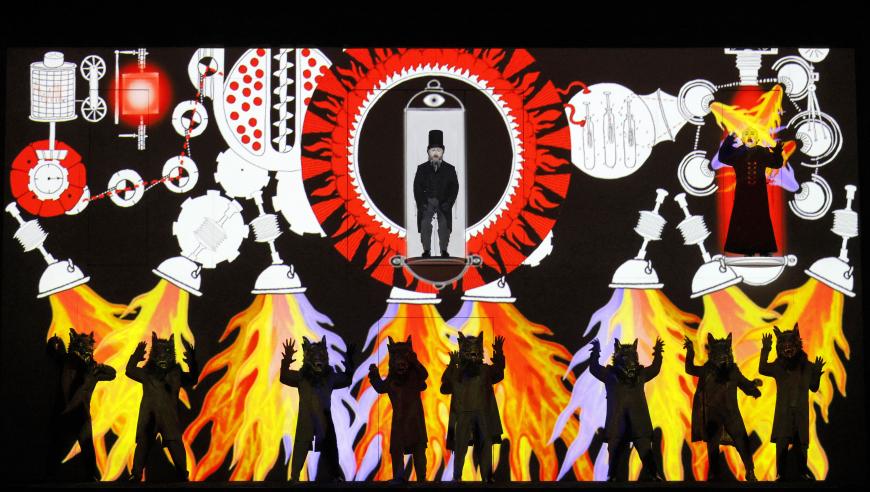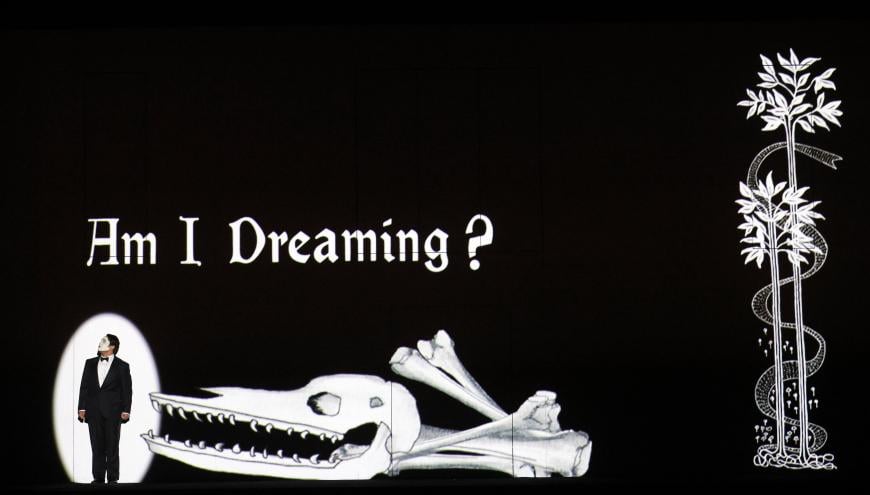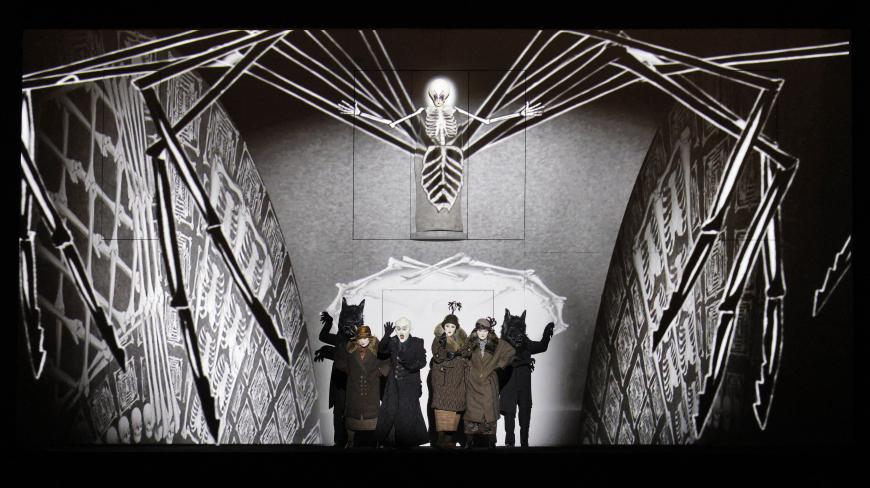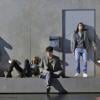
San Francisco Opera opened its 2024 summer season with a night at the movies. The live opera featured on the bill was The Magic Flute, Mozart’s enchanting if problematic fairy-tale blend of magical playfulness, romantic captivation, toxic male behavior, sober rites of passage, and ponderous Freemason symbology. The disparate elements have licensed all manner of directorial concepts over the years, surely few more elaborately conceived than the version that arrived at the War Memorial Opera House on May 30 for a nine-performance run through June 30.
First mounted in Berlin in 2012 and revived widely around the world, Barrie Kosky and Suzanne Andrade’s richly imagined production filters The Magic Flute through the visual lens of 1920s-era silent film. From start to finish of the two-hour-and-45-minute evening, animated imagery (designed by Paul Barritt) pours and pulses across a movie-screen set, complete with stuttery film-stock light, period-look title cards, and a few swatches of tinkly movie-house fortepiano accompaniment (Bryndon Hassman performing excepts from Mozart fantasias).

On the giant screen, hearts and butterflies flutter. Birds and blossoms swirl about. A giant snake devours the hero. Disembodied teeth chatter. The Queen of the Night (soprano Anna Simińska) is an enormous mechanical spider. Bizarre retrofuturist contraptions transport Tamino (tenor Amitai Pati), his beloved Pamina (soprano Christina Gansch, sporting a Louise Brooks look), and his traveling companion Papageno (bass-baritone Lauri Vasar, loose-limbed and Buster Keaton-esque in a mustard-colored plaid suit and battered hat).
As dazzling, witty, and at times wearyingly relentless as the animation is in its own right, the show’s transforming technical feat comes in how the imagery is blended with the singers. When the boy soprano spirits appear (on one of several rotating tab-like platforms positioned high on the screen), they hover in space on fluttering wings. Tamino and Pamina duck and cower from the projected flame of a fire-breathing beast. Leaning down to pet a black cat, Papageno gives the two-dimensional feline a palpable shiver of pleasure. (It’s one of the production’s puckish touches that the normally bird-centric character adopts a cat.)

Like Who Framed Roger Rabbit, the 1988 film that mingled live and animated characters, this Magic Flute is a perceptual joyride. The directors successfully address several things in the process. In addition to minting a fresh visual language for the fantastical elements intrinsic to the piece, they’ve found a way, with the title cards, projections, and mimed action, to at once convey and evade the baggy spoken dialogue in Emanuel Schikaneder’s libretto. The story, for the most part, whisks along.
As to how the production works in musical and theatrical terms, the answers are more mixed. By virtue of its physical design, the singers are often pinned in place on those tiny platforms. This happens early on, when the three ladies, emissaries of the Queen, materialize high above Tamino and fall into a jealous spat over the handsome hero. Animated hearts leap into action, bursting and colliding with each other. But what ought to play as an erotically charged comic scene feels static here, with those stylized valentines doing most of the work. In the Queen’s two famous arias, the singer’s tiny pop-out face gets overwhelmed by her character’s restless animated spider legs and gruesome skeletal body. Simińska sings the numbers solidly, but some of the vocal terror and steely edge is dwarfed by the visuals.

Among the principals, Gansch’s Pamina is the standout. With a soprano voice at once buttery and bleak, she makes her character’s second-act aria mourning Tamino’s apparent vanquishment a dramatic high point, her grief fully dimensionally human.
There are other musical and theatrical pleasures. Tenor Zhengyi Bai is a dynamically demonic Monostatos. Conductor Eun Sun Kim gives the trial music a solemn, watchful gravity. The three boy sopranos (Niko Min, Solah Malik, and Jacob A. Rainow) sing with sweet purity. The chorus projects a unified strength and conviction, the men in matching top hats as the last sepia light flickers over them.
It was something of a surprise on opening night that this Magic Flute stirred only a scattering of audience members in the orchestra to stand promptly at the end. Perhaps, given the evening’s cinematic immersion, they may have been a little dazed by it all.




